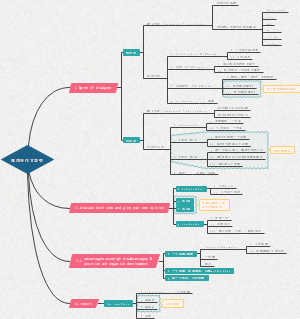导图社区 新编英语语法教程第一单元
- 618
- 6
- 2
- 举报
新编英语语法教程第一单元
新编英语语法教程第一单元:词素Morpheme、词Word、切分法。内容比较多,有需要的可以看下。
编辑于2022-02-24 20:28:40- 语法教程
- 相似推荐
- 大纲
Grammatical Hierarchy
语法层次
5个层次
词素Morpheme
自由词素Free Morpheme
定义
本身具有完整意义
能作为简单词simple word单独使用
应用
充当词根Root,+词缀Affix构成派生词Derivative
eg. kindly,unkindness
+其他自由词素,构成复合词
eg. bookstore,classmate
粘附词素Bound Morpheme
定义
没有词义或没有完整词义
不能单独而是需要粘附在其他形式上
类别
可以充当词根 不能独立存在 只能固定在某些词缀上构成一种特殊的派生词
词缀Affix
曲折词缀Inflectional Affix
名词复数标记-s/-es
名词属格标记-'s
第三人称单数现在时标记-s/-es
动词过去时标记-ed
动词-ed分词和-ing分词标记-ed/-ing
形容词和副词比较级和最高级标记-er/-est
派生词缀Derivational Affix
应用:+词根=派生词
类别
前缀Prefix
eg: anti-, co-,un-
后缀Suffix
eg. -ist, -ence, -ment
词素变体Allomorph
表示相同意义的词素在不同的环境中可有不同的变体
拼法上
eg. ir-, il-, im-, in-
语音上
eg.复数标记在cats中为/s/, 在dogs中为/z/
组合形式Combining Form
是一些源自希腊文和拉丁文等古典文学的外来词 与词缀的根本不同在于它们可能作为词根构成一种特殊的派生词 也可能单词等组合形式构成一种特殊的复合词
粘附词根Bound Root=原始派词根Primitive Derivative
可以充当词根
eg.-ceive, -duct, -dict, -lingu
combining form
+单词=复合词, 像前缀但不是
eg. arch-, mini-, mal-, multi-
新古典复合词Neo-classical Compound
组合形式彼此结合构成
eg. bio+logy=biology
词Word
根据构词法分类
简单词Simple Word=Morpheme Word=单一自由词素
eg. book,at,of,make
派生词Derivative=Root+派生词缀
+后缀
改性(主)
动变名
-ation, -ment, -al
形变名
-ness, -ity, ism
名形变动
-ify, -ize, -en
名变形
-y,-ish, -esque, -some, -ous
改义
-ster, -hood, -dom
+前缀
改义(主)
表否定的
eg.un-, in-, dis-
表相反的
eg.un-, in-, dis-, counter-
表方式的
eg.mis-, co-
表向背的
pro-, anti-
表程度or大小的
super-, ultra-, over-, under-, semi-
表时间的
pre-, fore-, post-
表方位的
sub-, inter-, trans-
改性
be-, en-/em-, a-
复合词Compound Word=自由词缀×n
eg. snowefall, bookstore
根据句法功能分类
封闭词类closed class=所有的功能词Function Word
介词Preposition
in, of, on, without, in spite of
代词Pronoun
you, he, one, which, this
限定词Determiner
a, the, this, some, any, to
连词Conjunction
and, or, but, because, when, if
助动词Auxiliary
do, can, may, must, will
开放词类open class=各种Content Word
名词Noun
形容词Adjective
副词Adverb
主动词Main Verb
work,give,make等
基数词Cardinal Numeral
序数词Ordinal Numeral
感叹词Interjection
词组Phrase
名词词组Noun Phrase
以名词为中心词 结构:① (限定词)+(前置修饰语)+名词+(后置修饰语) eg: all the college student, the tall boy sitting in the conner ②单个名词~( ̄▽ ̄)~*, 要在句子中才行
动词词组Verb Phrase
以主动词为中心词
根据组成
简单动词词组Simple
只包括一个主动词或者主动词带修饰语 eg: She looks pale. They fully appreciate our problems.
复杂动词词组Complex
由一个或一个以上的助动词+主动词构成 eg:It is getting dark. She ought to have told him about it. The children might have been playing in the garden. 也可以带修饰语 eg:I have rarely reviewed a more dishonest book.
根据动词形式
限定动词词组Finite
动词组的第一个词 若在形式上带有"时Tense"的标记 (有时还受主语的"人称Person"和"数Number"的制约) 则是限定动词词组
非限定动词词组Nonfinite
动词词组的第一个词 若是不变的动词形式 eg:We went there to see a firm. Having seen the firm, we had a discussion. Painted by a artist, the portrait is invaluable. 则是非限定动词词组
形容词词组
以形容词为中心词 可以①只包含一个形容词 ②(修饰语)+形容词+(后置修饰语/补足成分) eg:The weather is fine day. The course is pretty difficult. The work is too difficult to learn. It is bad for you.
副词词组
以副词为中心词 (修饰语)+介词+补足成分 eg: He speaks loudly and clearly. She spoke very loudly indeed. He lives farthest from the station.
介词词组
以介词为中心词, 但中心词不可能只有一个, 介词之后必须有补足成分, 有时之前还可带修饰语 (修饰语)+介词+补足成分 Do you think you can borrow some money from your frend? We are collecting money for the benefit of some orphans. That short story is based upon an incident in the author's life. The student consulted his adviser about the two courses. Food had been scarce since before the war. The weather has been fine except in the north. Now their footsteps could be heard directly above my head. They followed close behind me.
分句Clause
按照层次性理念,分句是建筑在词组基础上的,介乎词组与句子之间的语法单位; 从逻辑意义上看,分句又是形成“主谓结构”,从而带有述说性的词组序列。
独立分句和从属分句
独立分句Independent Clause
定义:不依附于其他结构而独立存在的分句
举例
eg.He knows everything about it. That hat does not fit;you may try another. Some of your answers were correct, but I do not remember which. His new book will soon come out. It is on grammar. 可以发现,这些分句结构完整,与其他分句用分号/句号是独立的。
从属分句Dependent/Subordinate Clause
定义:从属于其他结构的分句
举例
eg.I am sure he knows everything about it. If that hat does not fit, try another. I do not remember which of your answers were correct. His new book that will soon come out is on grammar. 或与其他分句在一个句子里,或无完整结构。
简单分句和复杂分句
简单分句Simple Clause
定义:仅包含一个主谓结构
举例
It is not true. He said that it was not true.
PS:一个单独出现的简单分句就是简单句
复杂分句Complex Clause
定义:带有其他主谓结构作为分句成分的分句
举例
What you said is not true. He said that what you said was not true.
PS:一个单独出现的复杂分句就是复杂句
主句和从句
主句Main Clause是相对于从句Subordinate Clause而言的
限定分句、非限定分句、无动词分句
限定分句Finite Clause
定义:以限定动词词组作谓语动词的分句
非限定分句Non-finite Clause
定义:以非限定动词词组即动词不定式、-ing分词、-ed分词)作谓语动词的分句
举例
I signed the paper to get the license. Renee bought a book to read on the plane. It is forbidden to smoke in this room. Can't you recall telling me that story last week? The man, wearing such dark glasses,obviously could not see clearly. Leaving the room, he tripped over the mat. Covered with confusion, they apologized abjectly. The discussion completed, the Chairman adjourned the meeting for half an hour
无动词分句Verbless Clause
定义:主谓结构中不带有任何形式的动词词组作谓语动词的分句
举例
Hungry and exhausted, the climbers returns. Confident of the justice of their cause, they agreed to put their case before the arbitration panel(仲裁小组) One of the most popular tourist sites in Italy, Pompeii was viewed by nearly two million visitors last year. Christmas then only days away, the family was pent up with excitement. 由上述例句可以看出,所谓“无动词分句”实际上是省略了主语和谓语动词的分句结构,上述前三例均属此类;无动词分句也可表示出自己的主语,仅仅省略了动词,上述最后一例便属此类。①
句子Sentence
句子建立在分句基础上,句子可以包含多个分句
句子与分句区别:结构形式无限
完全句Full Sentence和不完全句Minor Sentence
完全句
包括至少一个完整主谓结构的句子
作用:正式语体
不完全句
不具备完整主谓结构的句子
有的仅是省略句
例如:—When did he arrived? —Last night. —Who called this morning? —Johes.
有的依赖特定语境能用
No smoking!(禁止吸烟!) No parking!(禁止停车!) No admittance except on business!(闲人免进!) Fire!(着火啦!) Help!(救人啊!) No fishing!(禁止垂钓!)
作用:非正式语体尤其口语
正式语体中的不完全句用于强调,常出现于句首
简单句、并列句、复杂句、并列复杂句
简单句Simple Sentense
只包括一个主谓结构而且各个成分均为词组构成
I am more beautiful than so many people. He have made better grades in the past few years.
一个主谓结构,各个成分均为词组,但词组本身带有从属分句i
The boy I meet is handsome.
并列句
并列句×n 并列
复杂句
一个主谓结构,但包括从属分句
What he said is not ture. The boy can stay in the room so long as he keeps quite.
并列复杂句
并列句中但凡有一个复杂句
切分法
其中词义
Det
N
NP
Aux
Adv
MV
VP
Prep
PrepP









